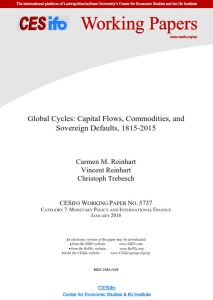Join getAbstract to access the summary!

Join getAbstract to access the summary!
Carmen M. Reinhart, Vincent Reinhart and Christoph Trebesch
Global Cycles
Capital Flows, Commodities, and Sovereign Defaults, 1815-2015
CESifo Group Munich, 2016
What's inside?
In regard to capital flows and sovereign defaults, history may not repeat itself, but it does rhyme.
Recommendation
History shows jumps in sovereign defaults – especially in emerging markets – following downturns in global capital flows, and fiscal crises are particularly acute after periods of both capital and commodity market declines. But as of the beginning of 2016, fallout from the 2012 cyclical drop in commodity prices and capital flows has been muted. Is the worst in sovereign defaults yet to come? Economists Carmen M. Reinhart, Vincent Reinhart and Christoph Trebesch review the past two centuries’ timelines of capital inflows and outflows to provide some perspective. getAbstract believes that economists, investors and executives will find their analysis a worthwhile recap of economic history for a glimpse into a possible future.
Summary
About the Authors
Carmen M. Reinhart is a professor at Harvard University. Vincent Reinhart is a visiting scholar at the American Enterprise Institute. Christoph Trebesch is an assistant professor at the University of Munich.
























Comment on this summary